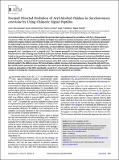Por favor, use este identificador para citar o enlazar a este item:
http://hdl.handle.net/10261/173884COMPARTIR / EXPORTAR:
 SHARE
BASE SHARE
BASE
|
|
| Visualizar otros formatos: MARC | Dublin Core | RDF | ORE | MODS | METS | DIDL | DATACITE | |

| Título: | Focused Directed Evolution of Aryl-Alcohol Oxidase in Saccharomyces cerevisiae by Using Chimeric Signal Peptides |
Autor: | Viña-González, Javier CSIC; González-Pérez, David CSIC ORCID; Ferreira, Patricia CSIC ORCID; Martínez, Ángel T. CSIC ORCID ; Alcalde Galeote, Miguel CSIC ORCID | Palabras clave: | Aryl-alcohol oxidase Focused Directed Evolution Saccharomyces cerevisiae Chimeric Signal Peptides |
Fecha de publicación: | sep-2015 | Editor: | American Society for Microbiology | Citación: | Viña-Gonzalez J, Gonzalez-Perez D, Ferreira P, Martinez AT, Alcalde M. 2015. Focused directed evolution of aryl-alcohol oxidase in Saccharomyces cerevisiae by using chimeric signal peptides. Appl Environ Microbiol 81:6451–6462. doi:10.1128/AEM.01966-15. | Resumen: | [EN] Aryl-alcohol oxidase (AAO) is an extracellular flavoprotein that supplies ligninolytic peroxidases with H2O2 during natural wood decay. With a broad substrate specificity and highly stereoselective reaction mechanism, AAO is an attractive candidate for studies into organic synthesis and synthetic biology, and yet the lack of suitable heterologous expression systems has precluded its engineering by directed evolution. In this study, the native signal sequence of AAO from Pleurotus eryngii was replaced by those of the mating -factor and the K1 killer toxin, as well as different chimeras of both prepro-leaders in order to drive secretion in Saccharomyces cerevisiae. The secretion of these AAO constructs increased in the following order: prepro-AAO > preproK-AAO > preKpro-AAO > preproK-AAO. The chimeric preproK-AAO was subjected to focused-directed evolution with the aid of a dual screening assay based on the Fenton reaction. Random mutagenesis and DNA recombination was concentrated on two protein segments (Met[1]-Val109 and Phe392-Gln566), and an array of improved variants was identified, among which the FX7 mutant (harboring the H91N mutation) showed a dramatic 96-fold improvement in total activity with secretion levels of 2 mg/liter. Analysis of the N-terminal sequence of the FX7 variant confirmed the correct processing of the preproK hybrid peptide by the KEX2 protease. FX7 showed higher stability in terms of pH and temperature, whereas the pH activity profiles and the Kinetic parameters were maintained. The Asn91 lies in the flavin attachment loop motif, and it is a highly conserved residue in all members of the GMC superfamily, except for P. eryngii and P. pulmonarius AAO. The in vitro involution of the enzyme by restoring the consensus ancestor Asn91 promoted AAO expression and stability. | Versión del editor: | http://dx.doi.org/10.1128/AEM.01966-15 | URI: | http://hdl.handle.net/10261/173884 | ISSN: | 0099-2240 | E-ISSN: | 1098-5336 |
| Aparece en las colecciones: | (ICP) Artículos |
Ficheros en este ítem:
| Fichero | Descripción | Tamaño | Formato | |
|---|---|---|---|---|
| AEM_Focused_viña_gonzalez_6451.pdf | 1,66 MB | Adobe PDF |  Visualizar/Abrir |
CORE Recommender
Page view(s)
308
checked on 19-abr-2024
Download(s)
243
checked on 19-abr-2024
Google ScholarTM
Check
NOTA: Los ítems de Digital.CSIC están protegidos por copyright, con todos los derechos reservados, a menos que se indique lo contrario.
